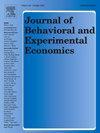Speaking between the lines: Speakers’ role in framing effect
IF 1.4
3区 经济学
Q2 ECONOMICS
Journal of Behavioral and Experimental Economics
Pub Date : 2025-01-22
DOI:10.1016/j.socec.2025.102337
引用次数: 0
Abstract
Framing effect research traditionally focuses on how different formulations of informationally equivalent messages affect listeners. Primarily, this equivalence is understood through a self-evident formal logic. Whether positively and negatively framed messages are equivalent in a broader, psychological sense has only recently been raised, and evidence remains scarce. We contribute by testing whether speakers use framing to implicitly convey their recommendations. In an experimental study, a scenario describing a potentially harmful procedure was presented to 119 participants, who were assigned roles of physicians or car mechanics. Their task was to convey instruction-based recommendations on whether to undertake the procedure, using only a positive or negative framing. The main finding is that participants in both roles used framing to implicitly convey recommendations, with physicians being more likely to use positive framing. Specifically, most participants instructed to recommend the procedure used positive framing. Nearly all mechanics used negative framing to discourage the procedure, while physicians were equally likely to use either frame. With no instruction on what to recommend, almost all physicians used positive framing, while mechanics were the same likely to use either frame. Presumably, this ability to speak between the lines implies also the ability to read between them. Should further research support this assumption, the effectivity of framing-based measures to shape behavior may hinge on the lens through which listeners interpret the intentions behind speakers’ framing choices.
言外之意:说话者在框架效应中的作用
框架效应研究传统上关注信息等价信息的不同表述如何影响听者。首先,这种等价是通过一个自明的形式逻辑来理解的。积极和消极框架信息是否在更广泛的心理意义上是等同的,直到最近才被提出,证据仍然很少。我们通过测试说话者是否使用框架来含蓄地传达他们的建议。在一项实验研究中,向119名参与者展示了一个描述潜在有害程序的场景,他们被分配为医生或汽车修理工。他们的任务是传达关于是否进行该程序的指导建议,只使用积极或消极的框架。主要发现是,两种角色的参与者都使用框架来含蓄地传达建议,医生更有可能使用积极的框架。具体来说,大多数参与者被指示推荐使用积极框架的程序。几乎所有的机械师都使用消极框架来阻止手术,而医生同样可能使用任何一种框架。在没有指导建议的情况下,几乎所有的医生都使用积极框架,而机械师也同样可能使用任何一种框架。据推测,这种言外之意的能力也意味着阅读言外之意的能力。如果进一步的研究支持这一假设,那么基于框架的措施来塑造行为的有效性可能取决于听者如何解读说话人框架选择背后的意图。
本文章由计算机程序翻译,如有差异,请以英文原文为准。
求助全文
约1分钟内获得全文
求助全文
来源期刊
CiteScore
2.60
自引率
12.50%
发文量
113
审稿时长
83 days
期刊介绍:
The Journal of Behavioral and Experimental Economics (formerly the Journal of Socio-Economics) welcomes submissions that deal with various economic topics but also involve issues that are related to other social sciences, especially psychology, or use experimental methods of inquiry. Thus, contributions in behavioral economics, experimental economics, economic psychology, and judgment and decision making are especially welcome. The journal is open to different research methodologies, as long as they are relevant to the topic and employed rigorously. Possible methodologies include, for example, experiments, surveys, empirical work, theoretical models, meta-analyses, case studies, and simulation-based analyses. Literature reviews that integrate findings from many studies are also welcome, but they should synthesize the literature in a useful manner and provide substantial contribution beyond what the reader could get by simply reading the abstracts of the cited papers. In empirical work, it is important that the results are not only statistically significant but also economically significant. A high contribution-to-length ratio is expected from published articles and therefore papers should not be unnecessarily long, and short articles are welcome. Articles should be written in a manner that is intelligible to our generalist readership. Book reviews are generally solicited but occasionally unsolicited reviews will also be published. Contact the Book Review Editor for related inquiries.

 求助内容:
求助内容: 应助结果提醒方式:
应助结果提醒方式:


